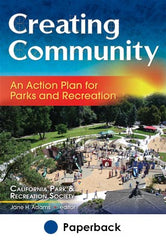Positioning can improve agencies' economic outlook
This is an excerpt from Creating Community by California Parks and Recreation Society (CPRS).
Positioning Your Agency
The term positioning is gaining prominence in parks and recreation because of the research of Dr. John L. Crompton from Texas A&M University's department of recreation, parks, and tourism sciences. According to Crompton, positioning is the process of fostering a desired state of the park and recreation agency in the minds of citizens and elected officials relative to their perception of other services that are the field's competitors for public money (Crompton, 2007). Positioning your park and recreation agency requires that you understand, provide, and highlight the work you do that is important to policy makers and constituents. This strategy is necessary because of the fierce competition for tax money among other public services, such as police, fire, planning, public works, health and welfare services, and redevelopment. We, as park and recreation professionals, must recognize this fierce competition and articulate the outcomes associated with our services, programs, and parks in language that conveys that the entire community benefits from these expenditures rather than only the individual who registers for a class, uses a recreation facility, attends an event in a park, or lives by a park. For instance, the mission of parks and recreation as defined in the VIP Action Plan addresses broader community-wide issues:
- Promoting health and wellness
- Protecting environmental resources
- Facilitating community problem solving
- Strengthening safety and security
Historically park and recreation providers have focused on the public benefits of parks and recreation, particularly in making budget presentations and in doing community outreach. Private outcomes also can be accrued from park and recreation services that might not be promoted as widely as the public benefits, yet they have a place in communicating the benefits of park and recreation services. This does not imply an "either-or" nature to the benefits; it is simply an acknowledgment that park and recreation providers must be able to articulate both the private and public benefits to a variety of audiences, including the policy makers, community organizations, the general public, and even the agency's own staff.
Table 2.1 displays the differing private and public outcomes of park and recreation services.
Following is the VIP Action Plan's positioning strategy:
By taking a customer-driven, outcome-oriented, and collaborative approach, the park and recreation profession can continue to play a central role in maintaining and improving quality of life in our communities.
This strategy recognizes that parks and recreation provides significant benefits to both individuals and communities. It acknowledges that public parks, recreation facilities, trails, open space, forests, wildlife refuges, and a rich mix of recreation programs and services enhance a community's competitive advantage as a place to live and to do business.
An agency's positioning strategy will rely on its ability to communicate and execute programs and services that are targeted to those issues that are important to policy makers and constituents. Failure to do so will weaken that agency's place within the community and may lessen its fiscal and human resources support.
Linking Mission to Your Community
The opportunities through which you carry out the mission must be consistent with the values and vision of your community. For example, if youth involvement is a priority of policy makers and the community, your agency should plan and promote the following aspects:
- How it fosters human development by offering before- and after-school programs and summer enrichment opportunities, internships, and junior camp counselor and other employment opportunities
- How it strengthens safety and security by engaging youth in meaningful activities led by trained professionals, particularly during nonschool hours
- How it supports economic development by hiring youth or hosting community, regional, or statewide sports tournaments
- How it promotes health and wellness by preventing alcohol and drug abuse and teen pregnancies by providing programs, spaces, and places for youth
- How it provides recreational experiences through all the youth activities you offer
Applying the mission articulated in the VIP Action Plan to community wants and needs can position your agency as a vital player in creating a vibrant and livable community.
This is an excerpt from Creating Community: An Action Plan for Parks and Recreation.
More Excerpts From Creating Community

Get the latest insights with regular newsletters, plus periodic product information and special insider offers.
JOIN NOW
Latest Posts
- Authenticity was key to McKinney’s NIL success
- AI—A new tool for sport PR pros
- Essential skills for sport PR practitioners
- Employ these tactics when pitching a story to the media
- How does ergonomic analysis and intervention enhance safety and reduce injury risk?
- Common movement patterns in competitive cycling


